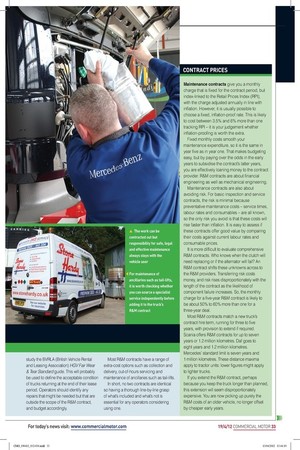CONTRACT PRICES
Page 26

If you've noticed an error in this article please click here to report it so we can fix it.
Maintenance contracts give you a monthly charge that is fixed for the contract period, but index-linked to the Retail Prices Index (RPI), with the charge adjusted annually in line with inflation. However, it is usually possible to choose a fixed, inflation-proof rate. This is likely to cost between 3.5% and 6% more than one tracking RPI – it is your judgement whether inflation-proofing is worth the extra.
Fixed monthly costs smooth your maintenance expenditure, so it is the same in year five as in year one. That makes budgeting easy, but by paying over the odds in the early years to subsidise the contract’s latter years, you are effectively loaning money to the contract provider. R&M contracts are about financial engineering as well as mechanical engineering.
Maintenance contracts are also about avoiding risk. For basic inspection and service contracts, the risk is minimal because preventative maintenance costs – service times, labour rates and consumables – are all known, so the only risk you avoid is that these costs will rise faster than inflation. It is easy to assess if these contracts offer good value by comparing their costs against current labour rates and consumable prices.
It is more difficult to evaluate comprehensive R&M contracts. Who knows when the clutch will need replacing or if the alternator will fail? An R&M contract shifts these unknowns across to the R&M providers. Transferring risk costs money, and risk rises disproportionately with the length of the contract as the likelihood of component failure increases. So, the monthly charge for a five-year R&M contract is likely to be about 50% to 60% more than one for a three-year deal.
Most R&M contracts match a new truck’s contract hire term, running for three to five years, with provision to extend if required. Scania offers R&M contracts for up to seven years or 1.2 million kilometres. Daf goes to eight years and 1.2 million kilometres.
Mercedes’ standard limit is seven years and 1 million kilometres. These distance maxima apply to tractor units: lower figures might apply to lighter trucks.
If you extend the R&M contract, perhaps because you keep the truck longer than planned, this extension will seem disproportionately expensive. You are now picking up purely the R&M costs of an older vehicle, no longer offset by cheaper early years.











































